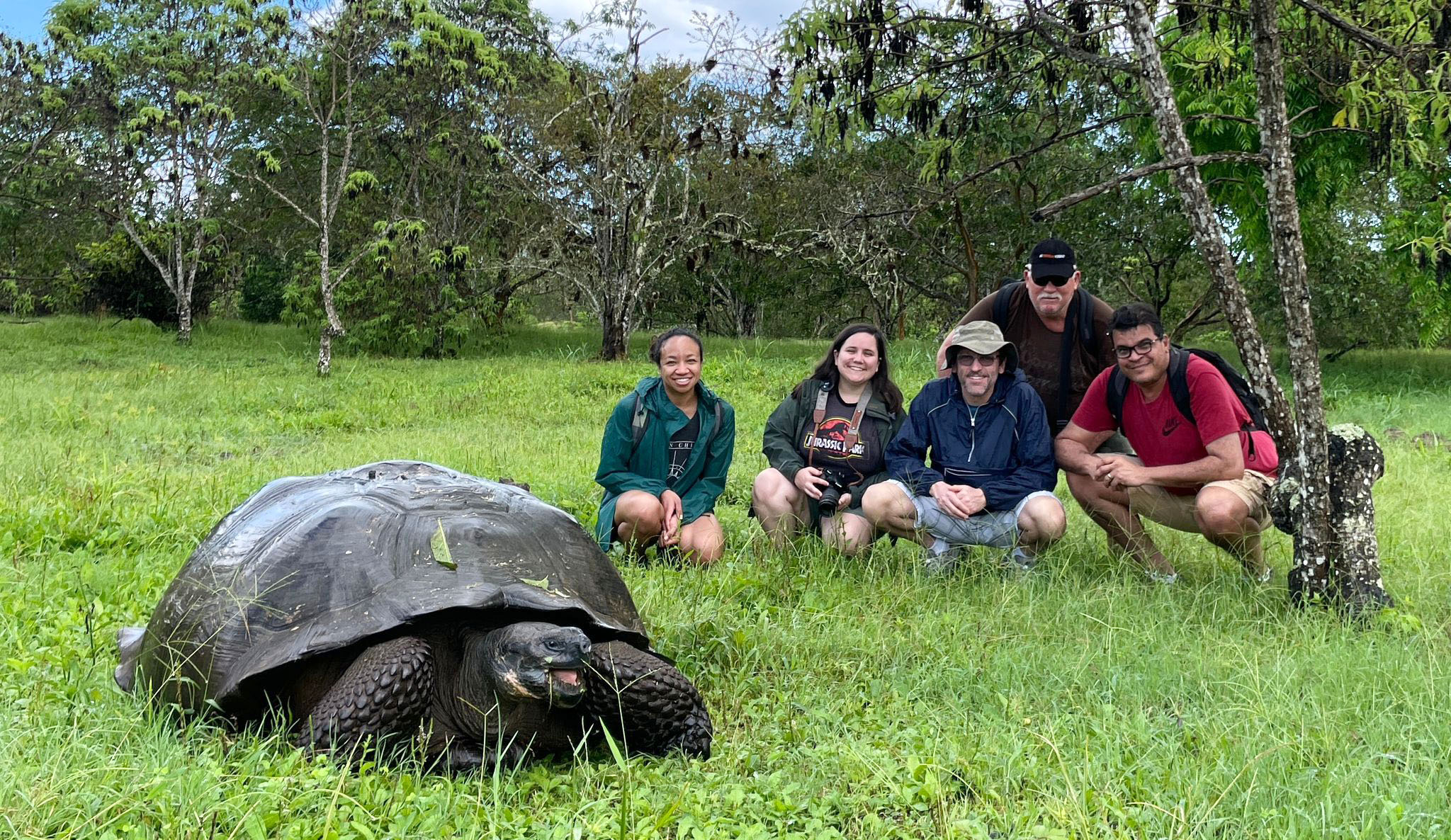International partnership allows release of once captive animals
Pictured above, from left: Veterinary Technician Nia Chau, Second-year Resident Dr. Kelsey Trumpp and Drs. Stephen Divers and Sam Rivera, kneeling, and Joe Flanagan, standing, with a giant tortoise.
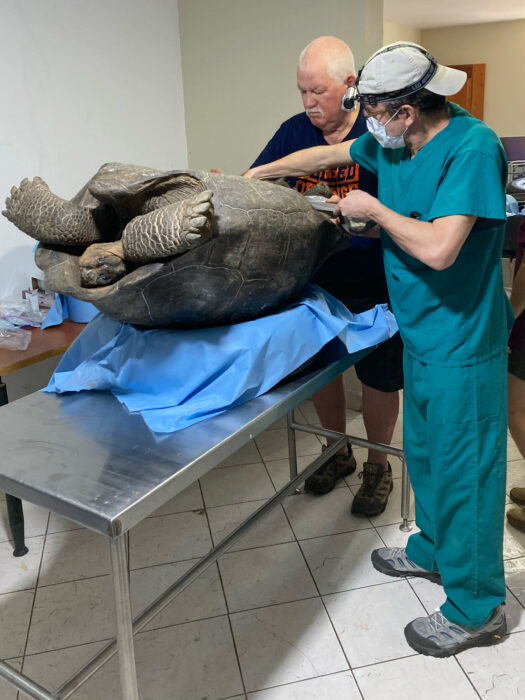
Drs. Joe Flanagan and Stephen Divers operate on a patient staged on a large tire in the surgical suite.
Why?
It’s the question that drives scientific discovery. It’s also the question most often asked of Dr. Stephen Divers and the medical team that assisted him with endoscopically sterilizing or sexing 59 tortoises on a trip to the Galápagos Islands earlier this year.
At the invitation of Dr. Joe Flanagan, senior veterinarian at the Houston (Texas) Zoo, Drs. Stephen Divers, UGA Professor of zoological medicine, and Sam Rivera, senior director of animal health at Zoo Atlanta, traveled to the Galápagos to perform laparoscopic sterilizations of young adult tortoises of hybrid genetics. They also performed endoscopic sexing of genetically pure juvenile tortoises raised in a captive breeding program for release in the wild. The work was done as an assist to the Galápagos Conservancy and Galápagos National Park in reestablishing native species of tortoises to the various islands that make up the archipelago.
Dr. Kelsey Trumpp, second-year resident in the CVM, and Nia Chau, a zoological medicine nurse at the Veterinary Teaching Hospital, traveled with Divers, Flanagan, and Rivera to assist and learn from the surgeries.
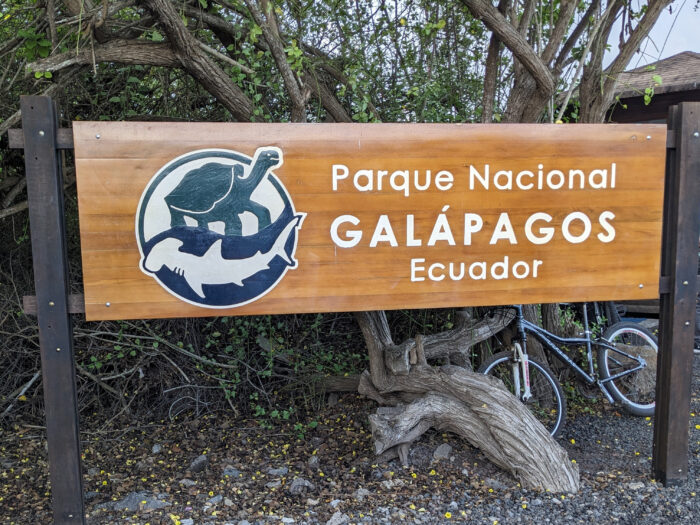
The Charles Darwin Research Station is located in Puerto Ayora, Santa Cruz Island. The station serves as a research base for scientists studying the Galápagos Islands.
The Galápagos as Lab
When the research vessel Beagle landed on the Galápagos in 1835 with Charles Darwin aboard, the islands were a living laboratory for studying some 2,000 unique species with pure genetic stock. Darwin made his name observing those animals for genetic changes or adaptations that occur in any given species over time.
Darwin’s observations of wildlife on the island inspired him to postulate on the origin of species, developing the theory of evolution and the notion of survival of the fittest. At that time, the isolation of the islands prevented the interbreeding of species unique to each. The insulation from outside influences was so absolute that the origins of tortoises native to the various islands that make up the whole of the Galápagos could be identified by the shapes of their shells.
But the lack of diversity ultimately delivered dilution. People drawn by whale hunting in the islands not only introduced competing species, but they also became predators, shuffling individual animals from island to island or removing them altogether to keep as pets, to populate zoos, or even for food.
In the 16th century Galápagos tortoises numbered more than 250,000. Today, there are approximately 35,000.
Divers, a faculty member on the Zoological Medicine Service at the UGA Veterinary Teaching Hospital, said the individuals sterilized earlier this year originated in the Galápagos but hatched in captivity to animals whose island of origin was unknown at the time. Once their ancestry could be determined using genetic tools, they were found to be of hybrid origin, with no island to call their permanent home. To be released in the wild, they would have to be sterilized to keep from contaminating the gene pool of tortoises on islands where they might be released.
“If you could release them back into the wild, they would have so much more space. Their welfare would be so much better,” Divers said. “If we could sterilize them, we could send them out even if they were hybrids (of mixed island genetics) knowing that they can’t reproduce so they live a happy life and don’t interfere with the pure genetic stock of that island.”
The Giant Tortoise Restoration Initiative began a project of captive rearing in 1965 to restore endangered species in the islands. By 2017, the program returned more than 7,000 juvenile tortoises to their islands of origin – including Española, Isabela, Pinzón, San Cristóbal, Santa Cruz, and Santiago. In May 2010, 39 hybrid adult tortoises Divers, Rivera and Flanagan sterilized in 2009 were released onto Pinta Island to help with vegetation management following the eradication of non-native goats. They paved the way for later release of a breeding population of tortoises by controlling vegetation previously managed by the goats.
The tortoises Divers and his team operated on were, to put it plainly, mutts. But they were carefully screened prior to sterilization to ensure that they were not made of stock valuable to efforts to replenish imperiled tortoise species.
“There is some disagreement as to whether animals from different islands are subspecies of the same species or if they’re genuinely different species,” said Trumpp, who will do her third year of residency at Zoo Atlanta. “While the different species or subspecies from different islands can interbreed and produce offspring there’s some evidence to suggest they may overall be less fertile and might be less robust and might not do as well and that’s why they don’t want those animals reproducing.”
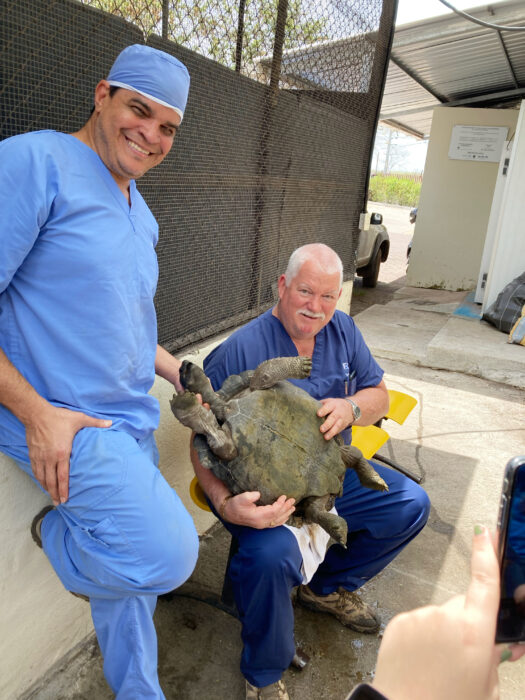
Drs. Sam Rivera and Joe Flanagan with a juvenile patient.
Why UGA?
The differences between Athens and the equatorial archipelago of volcanic islands known collectively as the Galápagos is more and less than the 2,500 miles that separate them. Athens is situated on a hilly patch of Georgia’s Piedmont (average elevation, 860 feet above sea level) and enjoys a humid subtropical climate. The state’s only native tortoise – the Gopher, weighing in at 15 pounds and measuring less than a foot long – is happier in the sandy soils of the Coastal Plain than the clay of Northeast Georgia.
Ironically, the Galapagos, a chain of islands straddling the Equator some 600 miles (1,000 km) west of the coast of Ecuador in the Pacific Ocean, is less tropical than one might imagine. The terrain, shaped by volcanic activity, is rugged. The highest point in the Galapagos Islands occurs at Volcán Wolf on Isabela Island and it reaches a height of 5,600 feet (1,707 m). The collection of native tortoise species in the Galápagos are the largest land tortoises in the world. The only member of the Chelonian order that is larger is the Leatherback sea turtle.
Lonesome George, the last known Pinta Island tortoise, died in 2012. He was thought to be 100 years old, weighed 200 pounds, and measured 5 feet in length.
So why invite a veterinarian based in Athens to the equator to lead the effort to rewild the Galápagos – aside from the fact that he brings his own veterinary nurse and resident, as well as state-of-the-art surgical equipment.
“Divers is world-renowned for his laparoscopic surgical skills. He teaches it and writes books about it. He’s the man,” Flanagan said. Divers regularly offers endoscopy training for veterinarians in the United States and worldwide.
Flanagan has nurtured a long fascination with the Galápagos (he’s visited 51 times) and serves as a consulting veterinarian to the Galápagos Conservancy, a Virginia-based nonprofit formed in 1985 to restore and protect the diversity of species on the islands.
“I have been a turtle nerd all my life and the Galápagos was always an interesting place to me,” Flanagan said. “I made the trip as a tourist in the early 1990s and then the following year worked with a vet student who was also doing his PhD in genetics of giant tortoises. He was going to the Galápagos to collect samples from the different populations. I said, ‘I’ll pay my own way. I’ll carry your stuff. I’ll do whatever it takes.’ Anyhow I finally talked him into letting me go with him.”
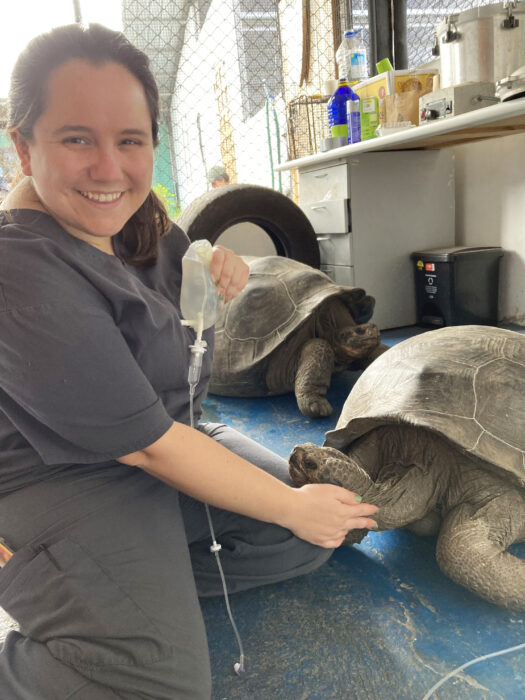
Dr. Kelsey Trumpp in recovery with a patient.
Teaching, Research, Service
Nearly half of the collection of animals housed at Zoo Atlanta consists of reptiles and amphibians, so Rivera, who has traveled to the Galápagos four times, had plenty of experience to offer in the operating theater, and to share with local staff.
“While we’re there we’re training veterinary staff in the Galápagos,” he said. “The veterinarian for the Galápagos National Park had an intern who was a veterinary technician, so we were exposing them to experiences they wouldn’t get anywhere else. We’re teaching them and we helped them learn by doing.”
The collaborative spirit of the trip – uniting the staff of two major metropolitan zoos and a research university – was a plus.
“We each bring a different set of expectations and experiences and we come together to help on this project,” Rivera said.
Nia Chau, a registered veterinary technician, or nurse, specializing in exotic species – basically anything other than companion animals, horses, cows, and pigs – did the heavy lifting for the team, they all say – keeping the animals sterile for surgery and overseeing anesthesia.
“Technicians do all the real work,” Flanagan said. “They make the veterinarians look good.”
Chau’s experience includes birds, reptiles, mammals, lions, tigers, red kangaroos, and koi fish (the anesthetizing agent goes into the water, and the fish are placed on a special table that circulates the water through the gills). Now, she and Trumpp can add “more tortoise anesthesia than they’ve ever done before” to their résumés, Divers said.
In fact, the use of epidural anesthesia in male tortoises prior to phallectomy was first reported on a prior trip Divers, Rivera and Flanagan made to the Galapagos.
“Although the males were sedated, they weren’t relaxed enough to do surgery,” Divers said of his first trip in 2009 when he, Rivera and Flanagan operated on the Pinta Island tortoises. “We had to come up with a new technique, so we came up with an epidural technique that hadn’t been reported before. Epidurals worked beautifully in the males. That was the first report of epidurals in males. Subsequently there have been numerous papers capitalizing on the technique.”
If Chau and Trumpp never scrub in on another giant tortoise sterilization again, they’ll have this experience, which is exceedingly rare in the world, Flanagan said. The entire team can claim bragging rights to having assisted in the conservation of some of the most unusual and widely known animals in the world. Those animals will be a living legacy for the team, Flanagan pointed out.
“The amazing thing that makes my head spin when I think about it is animals we worked on will be doing their thing for at least the next hundred years. It blows me away,” he said.
In the span of one week, the Galápagos Team touched both the world and the future.
“You may have seen stories in the news about the decrease in biodiversity and ecosystem health and trying to maintain wild areas, so I think this is one example where the University of Georgia has gotten directly involved with those kind of key components,” Divers said. “We’re in Athens, Georgia, and here we won’t see some of those biodiversity issues but we’re able to get involved in them and make a difference.”
